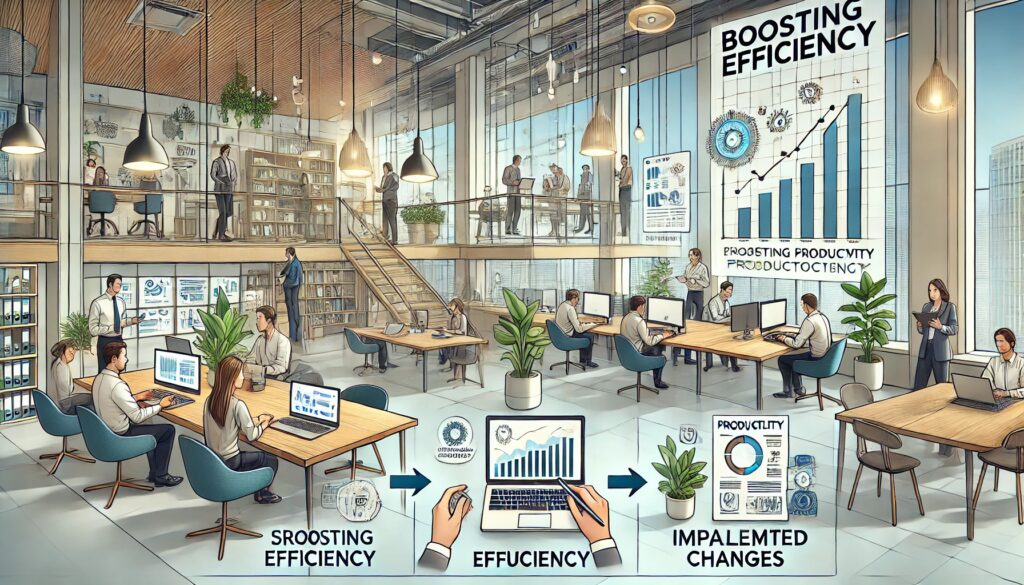AI in Business: Optimizing Supply Chains

In the ever-evolving realm of AI and business, supply chain optimization stands out as a crucial area where artificial intelligence can bring transformative changes. AI-driven solutions are redefining how businesses manage their supply chains, enhancing efficiency, reducing costs, and improving responsiveness. This comprehensive guide explores the intricacies of AI in supply chain optimization, delving into its technologies, implementation processes, applications, challenges, and future trends.
Understanding Supply Chain Optimization
Supply chain optimization involves streamlining every aspect of the supply chain, from procurement and production to delivery, to enhance performance and efficiency.
- Traditional vs. AI-Driven Supply Chain Optimization: Traditional methods rely heavily on historical data and manual processes, often resulting in inefficiencies and slow responses to changes. In contrast, AI-driven optimization leverages real-time data, predictive analytics, and machine learning to make proactive and intelligent decisions.
Key Benefits of Optimizing the Supply Chain:
- Increased Efficiency: AI can automate repetitive tasks and optimize processes, reducing operational costs.
- Improved Accuracy: Enhanced data analysis leads to more accurate demand forecasting and inventory management.
- Enhanced Responsiveness: AI enables real-time monitoring and quicker responses to disruptions and changes in demand.
Core Technologies in AI-Driven Supply Chain Optimization
- Machine Learning (ML)
- ML algorithms analyze vast amounts of data to identify patterns and make predictions, crucial for demand forecasting and inventory management.
- Predictive Analytics
- Uses historical data to predict future trends, helping businesses anticipate demand fluctuations and adjust accordingly.
- Internet of Things (IoT)
- IoT devices provide real-time data on inventory levels, equipment performance, and environmental conditions, enhancing visibility and control over the supply chain.
- Robotics and Automation
- Robotics automate repetitive tasks in warehousing and production, increasing efficiency and reducing human error.
- Blockchain Technology
- Ensures transparency and traceability in the supply chain, enhancing trust and security.
Implementation Process
Implementing AI in supply chain optimization involves several critical steps:
- Defining Business Objectives
- Identifying Key Goals and Challenges: Determine what you aim to achieve with AI, such as reducing costs, improving accuracy, or increasing responsiveness.
- Aligning with Business Strategy: Ensure that AI initiatives align with the overall business strategy and objectives.
- Data Collection and Integration
- Gathering Relevant Data: Collect data from various sources, including sales, inventory, and market trends.
- Ensuring Data Quality and Consistency: Clean and standardize data to ensure accuracy and reliability.
- Choosing the Right AI Tools and Platforms
- Criteria for Selecting AI Tools: Consider factors like scalability, integration capabilities, and user-friendliness.
- Popular AI Platforms for Supply Chain Optimization:
- IBM Watson
- SAP Leonardo
- Microsoft Dynamics
- Developing and Training Models
- Creating Models Based on Business Requirements: Develop models tailored to specific supply chain needs.
- Training Models with Historical and Real-Time Data: Use both historical and current data to train models, improving their accuracy and predictive power.
- Monitoring and Continuous Improvement
- Implementing Models in the Supply Chain Process: Integrate AI models into daily operations.
- Continuously Monitoring Performance: Regularly assess model performance and make necessary adjustments.
Use Cases and Applications
AI-driven supply chain optimization can be applied across various functions, bringing significant improvements:
- Demand Forecasting
- Predicting Future Demand: AI models analyze historical sales data and market trends to forecast future demand accurately.
- Adjusting Inventory Levels: Optimize inventory to meet predicted demand, reducing overstock and stockouts.
- Inventory Management
- Optimizing Stock Levels: AI helps maintain optimal stock levels, reducing carrying costs.
- Automating Reordering Processes: Automatically reorder stock based on real-time inventory data and demand forecasts.
- Supplier Management
- Evaluating and Selecting Suppliers: Use AI to assess supplier performance and reliability.
- Enhancing Supplier Relationships: Leverage data insights to improve communication and collaboration with suppliers.
- Logistics and Transportation
- Route Optimization for Delivery Efficiency: AI algorithms optimize delivery routes, reducing transportation costs and improving delivery times.
- Real-Time Tracking and Management of Shipments: Monitor shipments in real time to ensure timely and accurate deliveries.
- Risk Management
- Identifying Potential Disruptions: Predict and mitigate risks such as supply chain disruptions, delays, and quality issues.
- Developing Mitigation Strategies: Create proactive strategies to address potential risks and maintain supply chain continuity.
Challenges and Solutions
While AI offers substantial benefits, implementing it in supply chain optimization comes with challenges:
- Data Privacy and Security
- Ensuring Compliance with Regulations: Adhere to data protection laws like GDPR and CCPA.
- Implementing Robust Security Measures: Protect sensitive data from breaches and cyber threats.
- Data Quality and Integration
- Addressing Data Inconsistencies and Gaps: Ensure data accuracy and completeness.
- Ensuring Seamless Data Integration: Integrate data from various sources to create a unified view of the supply chain.
- Scalability and Flexibility
- Adapting AI Solutions to Business Growth: Ensure that AI tools can scale with the business.
- Maintaining Flexibility to Adapt to Changes: Keep AI systems flexible to adjust to evolving market conditions.
- Change Management
- Training Staff to Work with New Technologies: Provide comprehensive training to help employees adapt to AI tools.
- Managing Organizational Change Effectively: Implement change management strategies to facilitate smooth transitions.
Future Trends
The future of AI in supply chain optimization is promising, with several trends set to shape the industry:
- Increased Adoption of Autonomous Systems
- Autonomous vehicles and drones will revolutionize logistics and delivery.
- Enhanced Real-Time Analytics
- Real-time data analytics will enable more responsive and agile supply chains.
- Greater Integration of Blockchain for Transparency
- Blockchain will enhance transparency and traceability, building trust in supply chain processes.
- Expansion of Predictive Maintenance
- Predictive maintenance will minimize downtime and extend the lifespan of equipment.
Conclusion
AI is revolutionizing supply chain optimization, offering unparalleled efficiency, accuracy, and responsiveness. By leveraging advanced technologies and implementing them strategically, businesses can transform their supply chains, gaining a competitive edge in the market. As AI continues to evolve, its impact on supply chain optimization will only grow, paving the way for innovative and resilient supply chain practices.
Resources
- IBM Watson
- IBM Watson offers AI-driven solutions for various business applications, including supply chain optimization.
- SAP Leonardo
- SAP Leonardo integrates AI and machine learning to enhance supply chain operations.
- Microsoft Dynamics
- Microsoft Dynamics provides AI tools to improve supply chain efficiency and visibility.
- McKinsey & Company – The State of AI in 2020
- An in-depth analysis of AI adoption across various industries, highlighting trends and use cases in supply chain management.
- Gartner – Supply Chain Technology Trends
- Insights into the latest technology trends in supply chain management, including AI and machine learning.
- Harvard Business Review – How AI Will Transform Supply Chains
- Explores the impact of AI on supply chain management and the benefits of AI-driven supply chain optimization.
- Forbes – AI in Supply Chain
- Discusses the top benefits of using AI in supply chain management and optimization.
- MIT Sloan Management Review – AI in Supply Chains
- A detailed examination of how AI enhances supply chain processes and the methodologies involved.
- Deloitte – AI in the Supply Chain
- Provides an overview of AI’s role in supply chain planning and management, with practical insights.
- Accenture – The Impact of AI on Supply Chains
- Offers an in-depth look at the impact of AI on supply chain operations and the potential for future developments.
By incorporating these references and data from reputable sources, you can enhance the credibility and depth of your blog article on AI-driven supply chain optimization.





